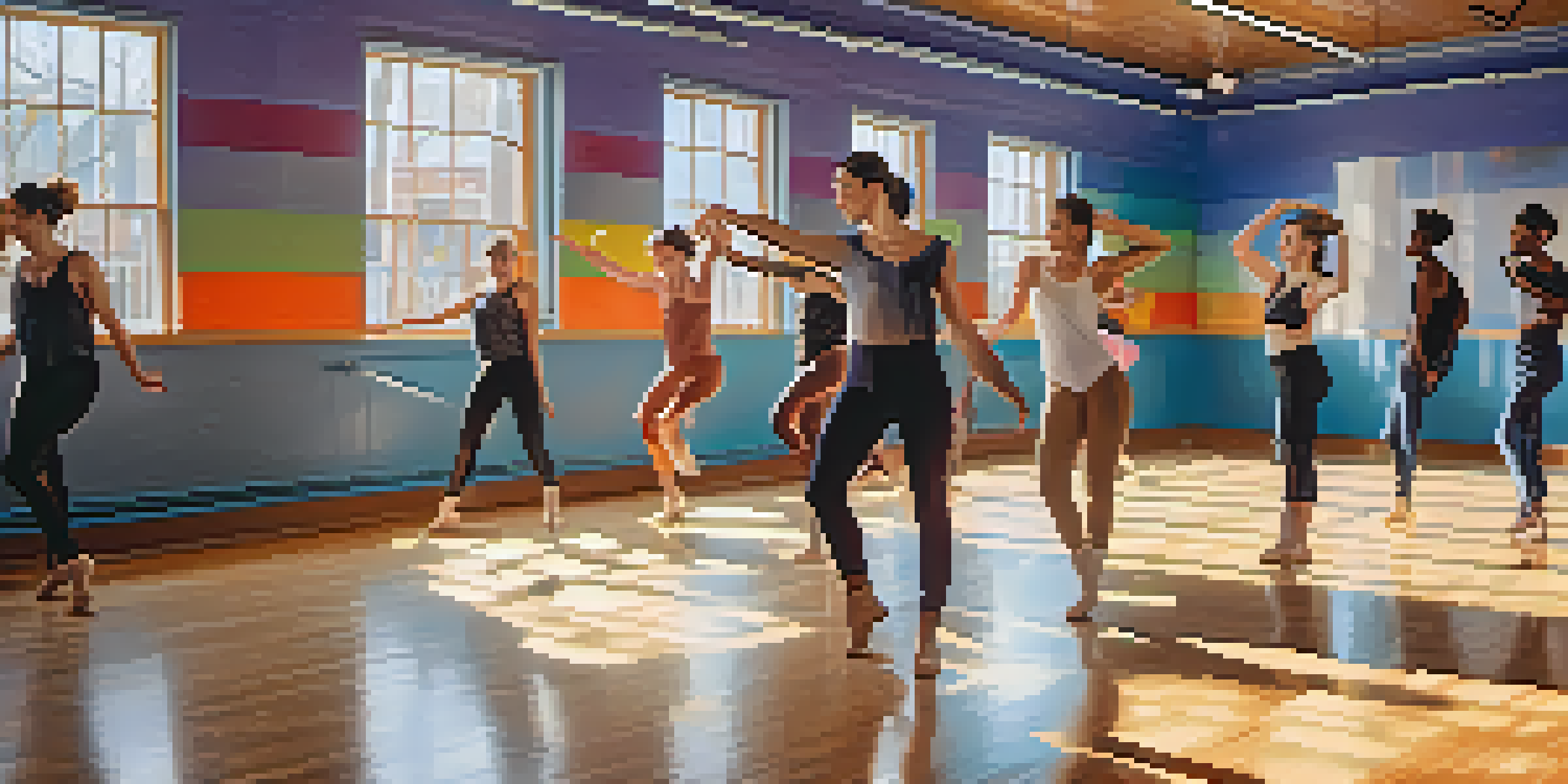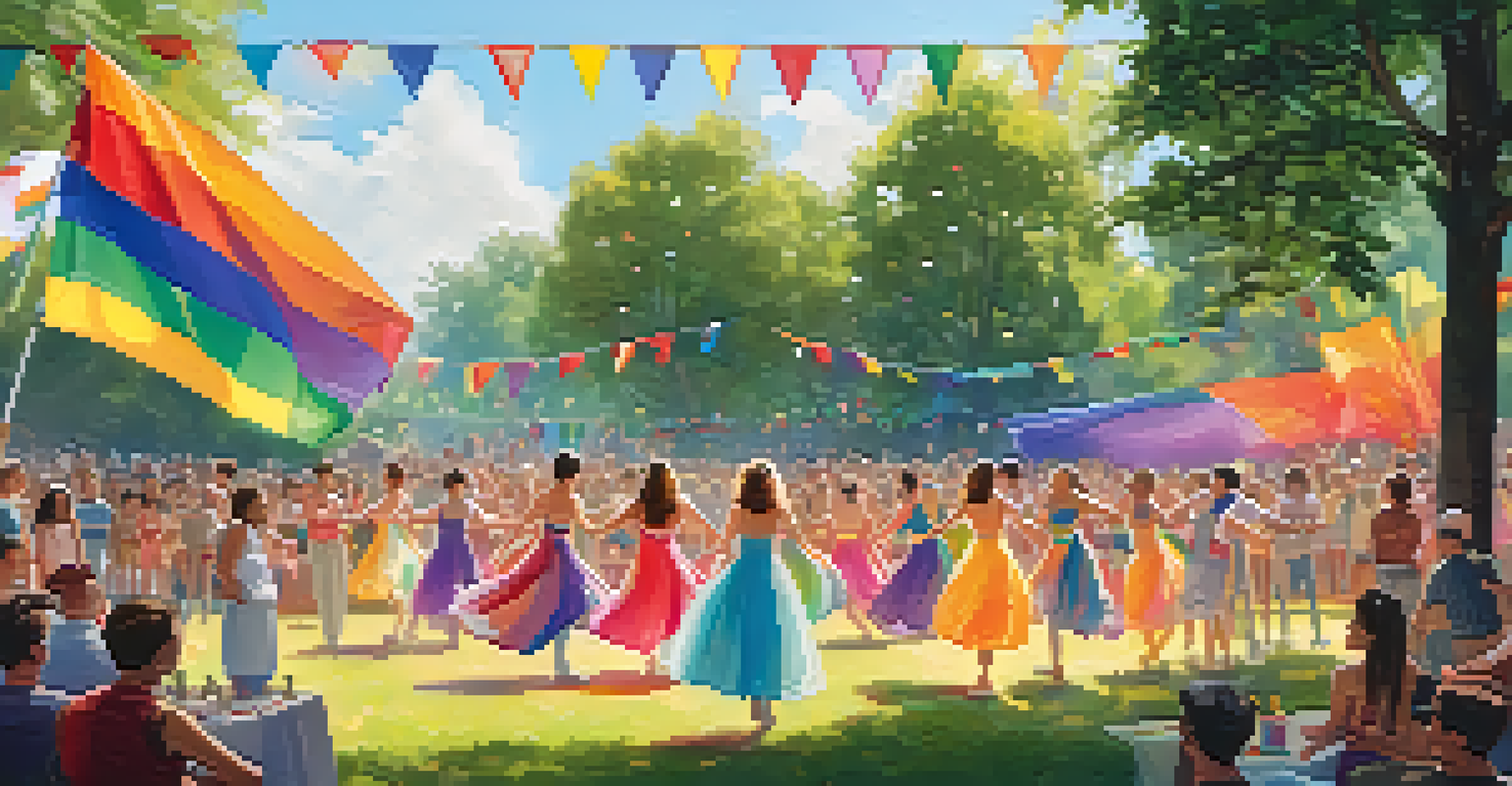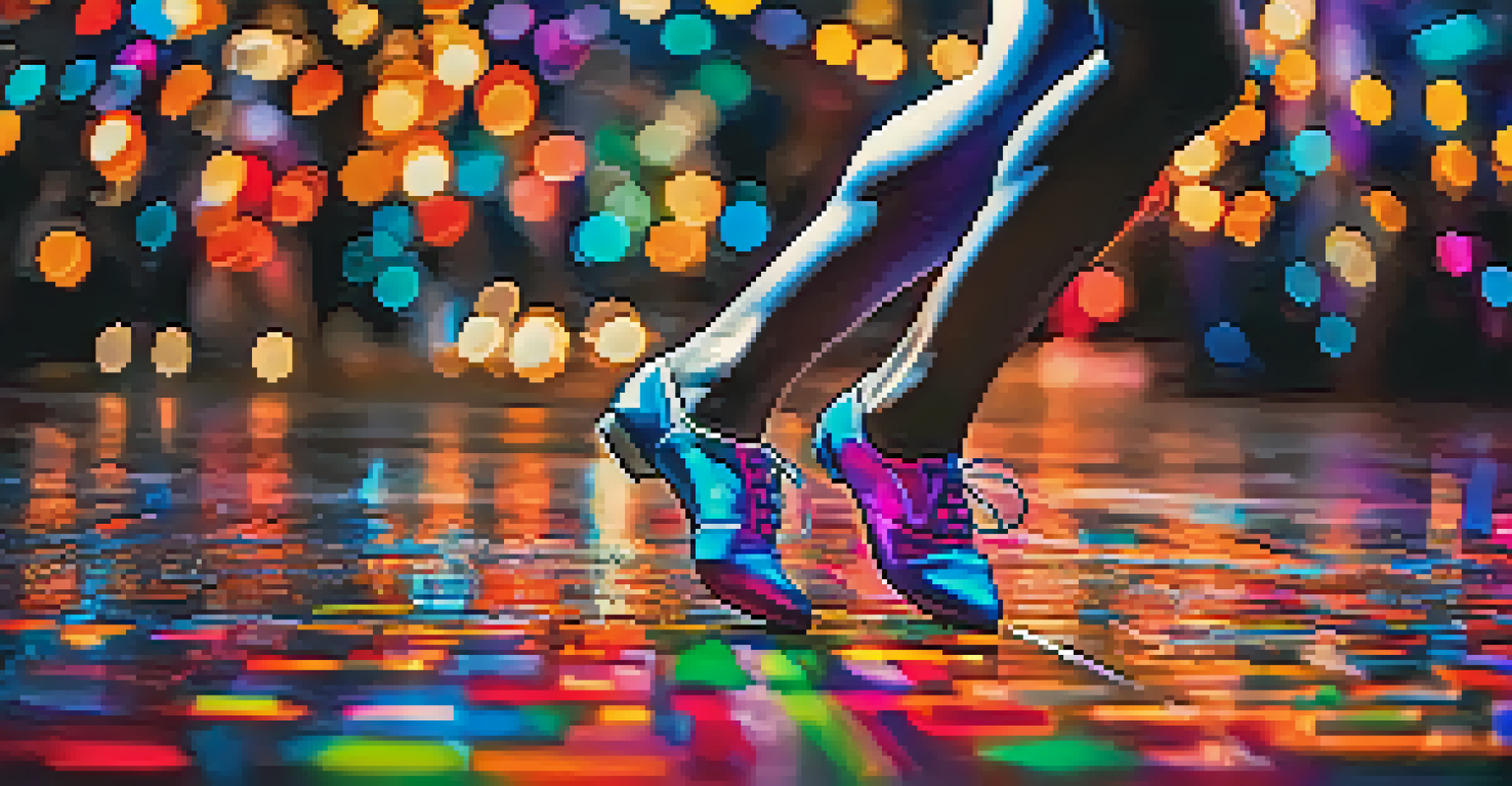Dance and Gender Identity: Voices from the LGBTQ+ Community

The Intersection of Dance and Gender Identity
Dance has long been a powerful medium for self-expression, allowing individuals to communicate their feelings and identities through movement. In the LGBTQ+ community, dance serves as a vital outlet for exploring and affirming gender identity. Whether through ballet, hip-hop, or contemporary styles, dancers often find their own narratives woven into the fabric of their performances.
Dance is the hidden language of the soul.
For many LGBTQ+ dancers, the act of moving their bodies becomes a celebration of who they are, breaking free from societal norms. The fluidity of dance mirrors the fluidity of gender, creating a space where traditional binaries can be challenged. This intersection allows for a richer understanding of identity, as it encourages individuals to embrace both their uniqueness and shared experiences.
Ultimately, dance acts as a bridge, connecting artists and audiences alike through shared stories of identity. It fosters dialogue about gender, helping to dismantle misconceptions and foster acceptance. As the LGBTQ+ community continues to evolve, so too does the dance landscape, reflecting these changes and pushing boundaries.
Historical Context: Dance in the LGBTQ+ Movement
To understand the current relationship between dance and gender identity, it's essential to look back at the historical context. The LGBTQ+ rights movement has roots in various cultural expressions, including dance, which has often served as a form of protest and celebration. From the early days of drag performances in underground clubs to modern dance festivals, these expressions have informed and shaped community identity.

During pivotal moments, such as the Stonewall riots, dance became a rallying cry for freedom and self-acceptance. LGBTQ+ individuals used dance as a means to unite, creating a sense of belonging and empowerment. This rich history highlights how dance transcends mere entertainment; it is a vital part of the narrative for many in the community.
Dance Celebrates Gender Expression
Dance serves as a vital outlet for LGBTQ+ individuals to explore and affirm their gender identities through movement.
As we celebrate progress, it's crucial to acknowledge how dance has played a role in advocating for visibility and rights. This legacy continues to inspire new generations of dancers who are forging their paths while honoring those who came before them. The dialogue between dance and gender identity remains a powerful testament to resilience and creativity.
Dance as a Safe Space for Expression
For many LGBTQ+ individuals, dance studios and performance spaces offer a sanctuary, a place where they can express themselves without fear of judgment. These environments often encourage creativity and authenticity, allowing dancers to explore their identities in a supportive community. It’s here that many find the courage to embrace their true selves.
The only way to make sense out of change is to plunge into it, move with it, and join the dance.
In these safe spaces, movement becomes a language of liberation, where the constraints of societal expectations can be shed. Dancers can experiment with different styles and forms, leading to a deep exploration of their identities. This freedom fosters a sense of belonging, reinforcing the idea that everyone deserves to be seen and celebrated.
Moreover, dance communities often prioritize inclusivity, promoting diverse representations of gender. This commitment to creating welcoming spaces ensures that all voices are heard and valued, contributing to a richer artistic landscape. Ultimately, these environments empower individuals to dance their truth and inspire others to do the same.
Influential LGBTQ+ Dancers and Choreographers
Throughout history, many LGBTQ+ dancers and choreographers have made significant contributions to the world of dance, shaping its evolution while amplifying diverse voices. Artists like Alvin Ailey and Pina Bausch not only transformed dance styles but also challenged norms surrounding gender and identity. Their work continues to inspire new generations of dancers to embrace their uniqueness.
More recently, figures like Billy Porter and Misty Copeland have gained recognition not just for their talent but also for their advocacy for LGBTQ+ rights. They use their platforms to raise awareness about the importance of representation in the arts. By sharing their journeys, these artists encourage others to find confidence in their identities and express themselves authentically through dance.
Historical Roots in Activism
The history of LGBTQ+ dance is intertwined with activism, using performance as a means of protest and community building.
The influence of these trailblazers extends beyond the stage; they serve as role models for aspiring dancers within the LGBTQ+ community. Their stories highlight that visibility matters, and representation in dance can empower individuals to pursue their passions unapologetically. As the dance world continues to evolve, these voices remain vital to fostering inclusivity and diversity.
The Role of Dance in LGBTQ+ Activism
Dance has historically played a pivotal role in LGBTQ+ activism, serving as a medium for protest and social change. From flash mobs advocating for equal rights to dance performances that challenge stereotypes, artists have harnessed the power of movement to convey messages of love, acceptance, and resilience. This unique form of activism allows for an emotional connection that traditional protests may not achieve.
By integrating dance into activism, the LGBTQ+ community can reach wider audiences, sparking conversations that may otherwise remain unaddressed. These performances often encourage viewers to reflect on their beliefs and biases, promoting empathy and understanding. Dance becomes a catalyst for change, breaking down barriers and fostering a sense of unity.
As society continues to grapple with issues of discrimination and inequality, the intersection of dance and activism remains crucial. The expressive nature of dance offers a powerful tool for advocacy, helping to create a world where everyone feels seen and valued. In this way, dance not only entertains but also empowers, reminding us of the transformative power of art.
Challenges Faced by LGBTQ+ Dancers
Despite the progress made in the dance world, LGBTQ+ dancers still face significant challenges in their careers. Issues such as discrimination, lack of representation, and feeling unwelcome in certain spaces can hinder their artistic expression. These obstacles can lead to feelings of isolation, making it essential for communities to address and dismantle these barriers.
The pressure to conform to traditional gender roles within dance can also create conflict for LGBTQ+ individuals. Many may feel compelled to suppress their identities to fit into conventional expectations, stifling their creativity and passion. It's crucial for dance institutions and organizations to foster environments that celebrate diversity and encourage authenticity.
Challenges in the Dance Community
Despite progress, LGBTQ+ dancers face challenges such as discrimination and pressure to conform, highlighting the need for more inclusive spaces.
By acknowledging these challenges, the dance community can work towards creating more inclusive spaces. Initiatives that promote representation and education about gender identity can empower LGBTQ+ dancers while providing them with the support they need. Change is possible when we prioritize inclusion and celebrate the richness of diverse identities in dance.
The Future of Dance and Gender Identity
As we look towards the future, the relationship between dance and gender identity is poised for continued evolution. With growing awareness and acceptance of diverse identities, dance communities are increasingly embracing inclusivity. This shift encourages experimentation and innovation, allowing artists to break free from traditional constraints and redefine what dance can be.
Emerging choreographers are already using their platforms to challenge norms and explore themes of gender fluidity and expression. This creative exploration reflects a broader societal change, where acceptance and understanding of gender diversity are becoming more commonplace. As these conversations grow, so too does the opportunity for dance to serve as a powerful vehicle for change.

Ultimately, the future of dance is bright and filled with potential. By nurturing talent from all backgrounds and celebrating diverse narratives, the dance community can continue to evolve and inspire. As we embrace the richness of human experience, we open up new possibilities for artistic expression that resonate with audiences everywhere.